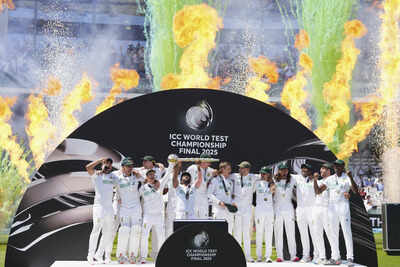As the 2023–2025 World Test Championship (WTC) cycle concludes, South Africa have emerged at the summit, securing 8 wins, 1 draw, and 3 losses from their 12-match schedule. In a surprising twist, Australia finished second—remaining unbeaten across all six series they played, yet missing the top spot on points.
Meanwhile, India—previous finalists in both 2021 and 2023—failed to qualify after losing the Border-Gavaskar Trophy to Australia and suffering a shock whitewash at home against New Zealand. The outcome not only reshaped the WTC final lineup but exposed the underlying complexities of a competition still defining its long-term structure.
WTC’s Purpose: Restoring Prestige to Test Cricket
Designed by the ICC to bring meaning to bilateral Test cricket, the World Test Championship assigns points to every match in a series, ensuring that each fixture carries weight. It’s the longest-format equivalent of a World Cup—a much-needed counterbalance to the franchise-heavy cricketing calendar.
The WTC currently includes the top 9 Test-playing nations:
🇦🇺 Australia | 🇧🇩 Bangladesh | 🏴 England | 🇮🇳 India | 🇳🇿 New Zealand | 🇵🇰 Pakistan | 🇿🇦 South Africa | 🇱🇰 Sri Lanka | 🌴 West Indies
The final is positioned as a marquee, standalone event—held in England, strategically timed in June to align with the cricket summer and global prime-time viewership.
India’s Absence = Commercial Risk
The absence of India in the 2025 final has already had tangible financial consequences. Ticket prices, initially set high based on India’s expected qualification, were slashed when the team missed out. Lord’s was reportedly set to lose up to £4 million ($5.4 million) in revenue.
In contrast, the 2023 final (India vs. Australia) drew 126 million viewers—the highest reach ever for a Test match and a 32% increase over the 2021 edition. India’s massive cricketing audience remains both the WTC’s greatest strength and its biggest dependency.
Should India Host the Final?
There is increasing lobbying for India to host the 2027 WTC Final. But geopolitics complicates the picture.
If Pakistan were to qualify alongside India, the final would likely not be held in India—a risk the ICC must weigh heavily.
England, by contrast, continues to offer neutral ground, reliable infrastructure, and time zones that favour both subcontinental and Western markets. Despite England not qualifying for the 2025 final, ticket demand remains strong.
Is the Current Format Fair?
The 2023–25 cycle has raised questions of competitive equity:
- South Africa reached the final without facing either Australia or England.
- England, who did face both, lost 22 points to over-rate penalties, costing them a shot at the final.
- The “Big Three” – India, Australia, England – arguably bear a greater burden in fixtures and penalties than others.
There are now proposals to restructure the WTC into a two-tier format by 2027, incorporating Ireland, Zimbabwe, and Afghanistan to create two six-team divisions. This shift could address competitive disparity—but may challenge broadcasting and commercial models that rely on marquee fixtures.
At 365247 Consultancy, we view the World Test Championship not just as a cricketing spectacle—but as a business case study in balancing tradition with innovation, and global equity with commercial reality.
Key Consulting Takeaways:
1. The WTC Needs Structural Safeguards
South Africa topping the table without facing key competitors reveals a structural flaw. As consultants, we recommend mandatory cross-pool matches between all top-tier teams to maintain sporting integrity.
2. England Must Remain Host – for Now
Neutral ground, favourable time zones, and consistent attendance data make England the lowest-risk, highest-reward venue. We advise the ICC to treat England as the de facto “WTC home”, while exploring rotational hosting post-2029.
3. India Drives Revenue—but Shouldn’t Dictate Format
Yes, India’s audience powers the sport’s economy. But over-reliance creates vulnerability. The ICC must diversify its media and fan engagement strategy, especially in emerging cricket markets like the US, Middle East, and Southeast Asia.
4. Over-rate Penalties Require Review
Commercially, no one benefits from top-tier teams missing finals due to technical penalties. A revised, graduated penalty system—focused on fines rather than points—would better protect the sport’s flagship event.
5. Future-Proofing Test Cricket
We urge boards to explore hybrid WTC fixtures—mixing traditional series with branded WTC matches that can be marketed like T20 events, while retaining the depth of red-ball cricket.
Whether you’re a cricket board, broadcaster, rights-holder, venue operator, or athlete entrepreneur — 365247 Consultancy helps design future-ready strategies across Test, franchise, and mixed-format ecosystems.
From format restructuring to ticketing revenue optimization, from venue strategy to fan engagement models—our insights turn tradition into transformation.
Let’s talk. Book your introductory call here.
Join the 365247 Community here.
IMAGE: AP


